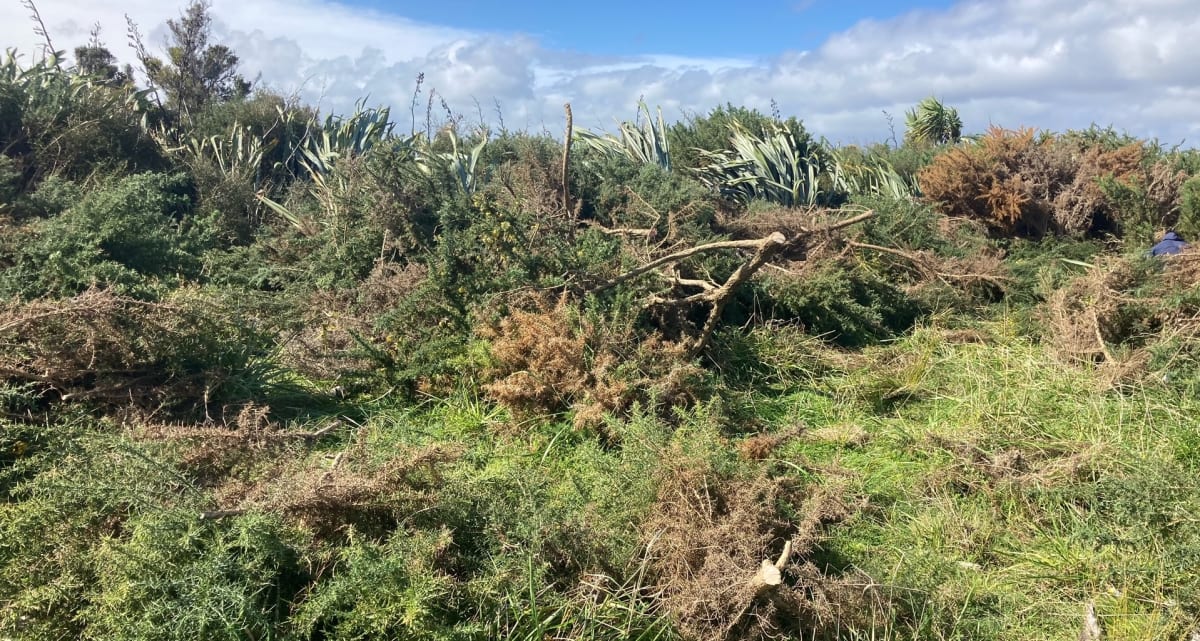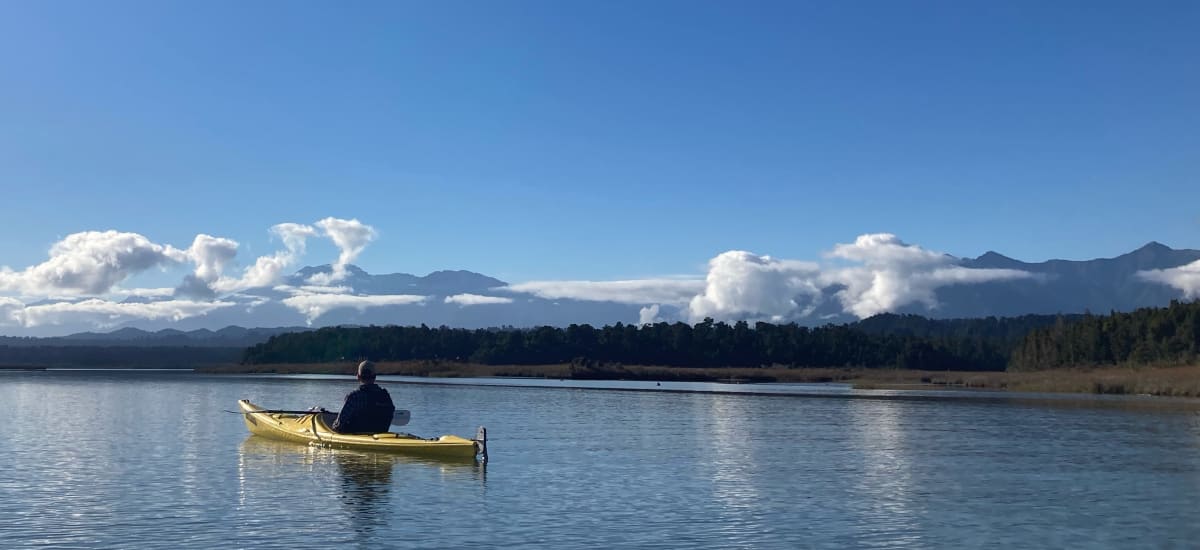
The phenomenal work ethic of a volunteer army has the gorse scourge at a West Coast beauty spot in retreat
For the second year running, volunteers from all over New Zealand have descended on picturesque Ōkārito Lagoon in South Westland to attack the gorse menace that threatens the Unesco World Heritage site.
“Gorsebusters”, the phenomenon sparked almost by accident last year by Ōkārito businessman Barry Hughes, is back bigger and better than ever as the West Coast basks in a record-breaking Indian summer.
The tiny community is hosting more than 80 people who arrived this week from as far away as Auckland, paying their own way to help out, armed to the teeth with loppers, pruning saws and other weapons of gorse destruction.
For Hughes and his wife Gemma, wrangling their tourism business, Ōkārito Kayaks, and a young family, it's a bit like seeing the cavalry coming over the hill.
“We're just stoked. It’s something we've wanted to do every year and struggled to make time for. We've done days here and there trimming back gorse but these guys are making a real impact.”
Brash yellow fringe
Although gorse in a forest environment can act as a nursery plant, sheltering native seedlings that will eventually shade and kill the pest plant, it behaves very differently around the 5000ha lagoon, Hughes says.
“Gorse in a wetland environment will become the dominant species. On regenerating farmland or old mining sites, gorse is great. It grows up and the natives come through and it goes away.”

But on the edge of a wetland, native species are naturally stunted by constant inundation and gorse takes over, crowding out the smaller shrubs and edging the tidal lagoon with a brash yellow fringe.
It's also getting in the way of a million-dollar view.
“From the lagoon, you can see 80km to the north and south, right to the top of Aoraki/Mt Cook and the central Southern Alps, and all you've got between you and the very tops of our highest peaks is native vegetation. So, with the gorse getting taller, we're facing the real loss of something special.”
Covid side effect
The gorsebusters campaign was born last year when Covid turned off the tourism tap for Ōkārito Kayaks and many other West Coast businesses.
“We didn't have any forward bookings for the business so we decided we'd set aside a week and muster maybe 20 or so mates to come in and hop in the kayaks and deal to the gorse. But it kind of started rolling when Development West Coast (DWC) got involved, which is really weird.”
The region's economic development agency is known for helping business rather than conservation efforts, and Hughes, a former conservation board member, says a few years ago he would not have been heard saying nice things about it.
But it was a DWC adviser who saw the potential for people to do something useful in a beautiful place at a time when many were feeling powerless in the face of the pandemic.
“It put out a press release and the phone started ringing the next morning with reporters wanting to know more. I did an interview with Jesse Mulligan on RNZ National that afternoon, TVNZ’s Seven Sharp did a piece and the emails started pinging with people offering to come down and help us.”
Gorse-haters unite
Stunned by the response, the couple set about finding accommodation for the influx of gorse warriors and working out how to feed them.
“We had this Hawke’s Bay farmer ring to say he was on his way and when I said we were looking pretty full, he said, ‘Nah, you don't understand – I hate gorse. We're coming down.’”
The farmer and his wife arrived with supplies plus an arsenal of gorsebusting gear and proved formidable in the field, Hughes says.
Offers of food for the volunteers also came flooding in, including a prodigious 20kg of muesli from a Nelson firm, and locals pitched in to help.
“We ended up with 60 people a day for six days, feeding them and accommodating them. DoC opened the Old School House hut to put people up. Local baches and the community campground were offered free for the week and iwi gave us their blessing and ran a barbecue. We thought, ‘This is great - let’s roll with it.’”

What on earth would prompt such a rush of enthusiasm – not to mention altruism – for whacking gorse in the West Cost wilderness when most New Zealanders were hunkering down at home with Netflix, avoiding Covid and the company of strangers?
“I think it gave people a sense of agency,” Hughes says.
“Around that time there were so many negative stories coming out about the glacier region – a lot of that ghost-town stuff. Gorsebusters was like, 'Here's something we can do that's positive.’ I think that was an underlying motivation.”
Comrades in arms
There was also, perhaps, a yearning for the camaraderie of working with others to achieve a tangible result after months of anxiety and isolation.
Nor would watching the sunrise over the Southern Alps from still waters on a West Coast morning, or the sunset over the Tasman, have taken away from the appeal of a working holiday.

Whatever their motives, last year's volunteers made a serious dent in the gorse pestilence, Hughes says, and this year they're back in even bigger numbers to continue the job.
Vaccination passes have been a must and some volunteers from Taupō got as far as Nelson when positive rapid antigen tests forced them to turn back.
“This time we started planning in August. We think there's a social maximum for the town. We don't want the locals to feel overrun, so we decided on 90 extra people a day max.”
The couple underwrote costs for last year's gorsebusters' event but with the support they received the bill was not as big as expected.
“This year, the Ōkārito Community Association gave us $5000, DoC has paid for the herbicide gel and the manufacturers didn't charge for the freight. There’s no charge for accommodation or for food.”
It all helps to make it an affordable week for the volunteers who come from all walks of life, Hughes says.
“We don't want to exclude people. We’ve had some quite affluent volunteers, but then we've also had people that probably didn't have a pot to piss in.
“Last year we discouraged financial contributions. This year we're saying it'll help but it's not a requirement and we've had a couple of sizeable donations.”
Development West Coast has also kicked in $10,000 from its regional events fund, Hughes says, recognising the reputational benefit to a region often in the news for berating DoC and the conservationist lobby.
Gnarly pest
Each morning this week, the gorsebusters have headed out onto Ōkārito Lagoon in kayaks and on inflatables to do battle with some of the gnarliest gorse in the country.
Retired Auckland businessman Tony Cunningham says it's hard yakka but worth it.
He was inspired to sign up as a gorsebuster last year after seeing a 1 News story about the event, but missed out.
This year, he registered early.
“I do some volunteer work at Long Bay Regional Park up north, but this is different. These gorse bushes are actually trees - the biggest stump was 100mm across.”

Gorse at Ōkārito grows along the ground, snaking in among the native shrubs, and the volunteers have to fight their way though the undergrowth tracking the tree to its roots.
Trunks are cut and stumps painted with poison gel, a method that ensures the herbicide stays out of the waterways and doesn't kill neighbouring plants.
“It's really satisfying,” Cunningham says.
“When you see the big area of gorse at first it's daunting, like a wall. But you get stuck in and at the end of the day it's gone - brilliant!”
The weather's been kind this year, apart from on Tuesday morning when the marquee for meals and socialising blew down.
“We just set up breakfast in our neighbours' garages and put the tent back up when the weather cleared. We're a bit No 8 wire, but it means we're flexible,” says the unflappable Hughes.
A free concert for the workers by Christchurch musician Adam McGrath had to be scrapped but was rescheduled as a Zoom event projected on an improvised screen made from a large white-painted board.
Hughes has high praise for the efforts of the volunteers.
“They've consolidated what we did last year and tackled new areas of gorse as well. It’s making a real difference. Their work ethic is phenomenal.”
Made with the support of the Public Interest Journalism Fund








